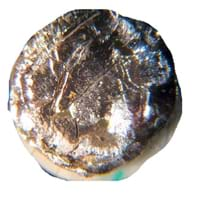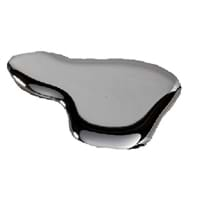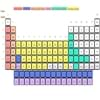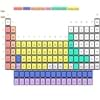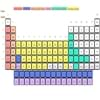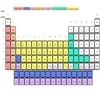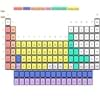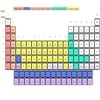Americium vs Mercury
Periodic Table
Symbol
Am
Hg
Group Number
Not Available
12
6
Period Number
7
6
Block
f block
d block
Element Family
Actinide
Transition Metal
CAS Number
7440359
99+
7439976
99+
Space Group Name
P63/mmc
R_ 3m
Space Group Number
194.00
5
166.00
6
Facts
Interesting Facts
- Americium metal is produced by bombarding Plutonium with Neutrons.
- Americium metal was discovered as a by-product while testing an atomic bomb (Manhattan Project).
- At room temperature mercury is found in a liquid state.
- A coin of pound or rupees floats in mercury.
- Because of its low melting point and boiling point it is used in thermometers.
Sources
Obtained By Bombarding Plutonium with Neutrons
Mining, Ores of Minerals
History
Who Discovered
Glenn T. Seaborg, Ralph A. James, Leon O. Morgan, Albert Ghiorso
Ancient Chinese and Indians
Discovery
In 1944
Before 2000 BCE
Abundance
Abundance In Earth's Crust
Not Available
0.05 %
9
Uses
Uses & Benefits
- Americium metal is used in smoke detection alarms.
- In the future, this metal has a potential to be used in batteries of spacecrafts.
- It is a liquid metal at room temperature, but it is a toxic heavy metal and hence many uses of mercury are under review or phased out.
- It is manly used as a catalysts in chemical industry.
Industrial Uses
NA
Electrical Industry, Electronic Industry
Medical Uses
NA
Dentistry
Other Uses
Alloys, Nuclear Research, Research Purposes
Alloys, Mirror Manufacturing, Pharmaceutical Industry
Biological Properties
Toxicity
Toxic
Highly Toxic
Present in Human Body
No
Yes
In Blood
0.00 Blood/mg dm-3
37
0.01 Blood/mg dm-3
23
In Bone
0.00 p.p.m.
36
0.45 p.p.m.
19
Physical Properties
Melting Point
994.00 °C
99+
Not Available
Boiling Point
2,607.00 °C
99+
356.58 °C
99+
Appearance
Physical State
Solid
Liquid
Color
Silvery White
Silver
Luster
NA
NA
Hardness
Speed of Sound
Not Available
1,451.40 m/s
99+
Optical Properties
Refractive Index
Not Available
1.00
3
Reflectivity
Not Available
73.00 %
8
Allotropes
No
No
α Allotropes
Not Available
Not Available
β Allotropes
Not Available
Not Available
γ Allotropes
Not Available
Not Available
Chemical Properties
Chemical Formula
Am
Hg
Isotopes
Known Isotopes
16
23
34
5
Electronegativity
Pauling Electronegativity
1.30
32
2.00
7
Sanderson Electronegativity
Not Available
2.20
7
Allred Rochow Electronegativity
1.20
27
1.44
17
Mulliken-Jaffe Electronegativity
Not Available
1.81
9
Allen Electronegativity
Not Available
1.44
30
Electropositivity
Pauling Electropositivity
2.70
22
2.00
99+
Ionization Energies
1st Energy Level
578.00 kJ/mol
99+
1,007.10 kJ/mol
4
2nd Energy Level
1,158.00 kJ/mol
99+
1,810.00 kJ/mol
20
3rd Energy Level
2,132.00 kJ/mol
99+
3,300.00 kJ/mol
20
4th Energy Level
3,493.00 kJ/mol
99+
Not Available
Electrochemical Equivalent
3.02 g/amp-hr
17
3.74 g/amp-hr
10
Electron Work Function
Not Available
4.49 eV
15
Other Chemical Properties
Ionization, Radioactive Isotopes, Radioactivity, Solubility
Flammability, Ionization, Solubility
Atomic Properties
Atomic Number
95
23
80
36
Electron Configuration
[Rn] 5f7 7s2
[Xe] 4f14 5d10 6s2
Crystal Structure
Double Hexagonal Close Packed (DHCP)
Rhombohedral (RHO)
Crystal Lattice
DHCP-Crystal-Structure-of-Americium.jpg#100
RHO-Crystal-Structure-of-Mercury.jpg#100
Atom
Number of Protons
95
23
80
36
Number of Neutrons
148
12
121
22
Number of Electrons
95
23
80
36
Radius of an Atom
Atomic Radius
173.00 pm
21
151.00 pm
32
Covalent Radius
180.00 pm
21
132.00 pm
99+
Van der Waals Radius
244.00 pm
10
155.00 pm
99+
Atomic Weight
243.00 amu
20
200.59 amu
32
Atomic Volume
17.86 cm3/mol
29
14.82 cm3/mol
35
Adjacent Atomic Numbers
Valence Electron Potential
44.00 (-eV)
40
28.20 (-eV)
99+
Lattice Constant
346.81 pm
99+
300.50 pm
99+
Lattice Angles
π/2, π/2, 2 π/3
NA
Lattice C/A Ratio
Not Available
Not Available
Mechanical Properties
Density
Density At Room Temperature
12.00 g/cm3
30
13.53 g/cm3
24
Tensile Strength
Not Available
Not Available
Viscosity
Not Available
0.00
1
Vapor Pressure
Vapor Pressure at 1000 K
0.00 (Pa)
13
Not Available
Elasticity properties
Poisson Ratio
Not Available
Not Available
Other Mechanical Properties
NA
NA
Magnetic Properties
Magnetic Characteristics
Specific Gravity
13.67
15
13.53
16
Magnetic Ordering
Paramagnetic
Diamagnetic
Electrical Properties
Electrical Property
Unknown
Conductor
Resistivity
0.69 nΩ·m
99+
961.00 nΩ·m
1
Electrical Conductivity
0.02 106/cm Ω
99+
0.01 106/cm Ω
99+
Electron Affinity
Not Available
0.00 kJ/mol
40
Thermal Properties
Specific Heat
0.11 J/(kg K)
99+
0.14 J/(kg K)
38
Molar Heat Capacity
62.70 J/mol·K
1
27.98 J/mol·K
13
Thermal Conductivity
10.00 W/m·K
99+
8.30 W/m·K
99+
Critical Temperature
Not Available
1,750.00 K
6
Thermal Expansion
Not Available
60.40 µm/(m·K)
5
Enthalpy
Enthalpy of Vaporization
Not Available
56.90 kJ/mol
99+
Enthalpy of Fusion
14.39 kJ/mol
24
2.29 kJ/mol
99+
Enthalpy of Atomization
268.00 kJ/mol
40
61.50 kJ/mol
99+
Standard Molar Entropy
Not Available
75.80 J/mol.K
6
|
||
|
||
|
